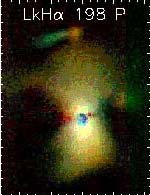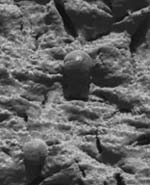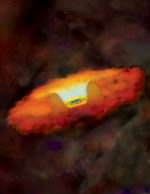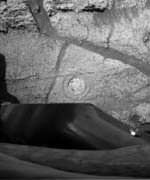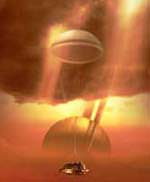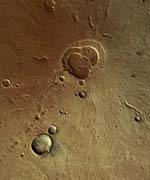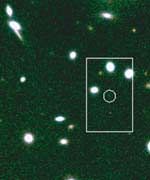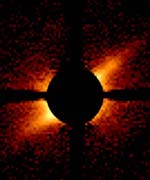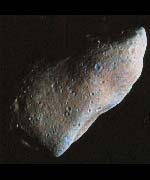
Image credit: NASA
For a few hours on January 13, 2004, astronomers thought a 30-meter wide asteroid might hit the Earth. The asteroid AL00667 seemed to be on a direct course for the Northern Hemisphere, due to strike in less than two days.
A 30-meter asteroid is larger than a tennis court. An asteroid of this size would have broken up in the atmosphere, creating a one-megaton blast. If it exploded high enough, the asteroid probably wouldn’t have caused any damage. The shock wave from the blast would have become a sonic boom by the time it reached the ground. But an explosion lower in the atmosphere could have caused considerable damage.
Astronomers who knew about the asteroid believed an impact was not likely, but they couldn’t rule out the possibility, either. So they faced a dilemma – should they warn others about something that could end up passing us by?
President Bush was preparing to make a speech at NASA headquarters the next day. He planned to talk about sending a man back to the moon and then on to Mars, but news of an approaching asteroid may have caused him to make a very different kind of announcement.
The asteroid, which has since been renamed 2004 AS1, actually passed by at about 12 million kilometers away, or 32 times the Earth-moon distance. The asteroid also turned out to be 10 times larger than first thought (about 300 meters wide – or about the height of the Eiffel Tower).
Some recent news reports say that Clark Chapman, an astronomer with the Southwest Research Institute, was moments away from calling President Bush and warning him about the asteroid. Chapman, however, adamantly denies this.
“It is absurd to think that any of us in the loop would have called the White House,” states Chapman. “Hell, we wouldn’t even have gotten through. All I was thinking about was recommending to Don Yeomans, who is in charge of JPL’s [the Jet Propulsion Laboratory’s] Near Earth Object Program office, that he inform people at NASA. It would have had to go through several layers of hierarchy before it got to anyone who would have been in a position to go higher than NASA. And Yeomans says that he wouldn’t have acted on my advice, preferring to wait for further confirmation of the object.”
The difference between the initial estimates and the final result highlights the difficulty of monitoring the skies for small Near Earth Objects (NEOs). For 2004 AS1, astronomers knew the asteroid could be either big and far away, or small and close by.
“It’s rather like noticing something in the sky out of your car window that appears to be moving along with you,” explains Alan Harris of the Space Science Institute. “It could be a bird close to your car flying along at close to the same speed, or it could be a plane in the distance that only seems to be pacing your car.”
Over the next few weeks after January 13, the asteroid came even closer to Earth, but it still passed many times farther away than the moon. There are many asteroids that routinely pass much closer to the Earth, says Harris, and asteroids the size and distance of 2004 AS1 are “a dime a dozen.”
“I think we all realized the odds were in favor of the larger, more distant object, rather than a real impactor on its way in,” says Harris.
Chapman first discussed these events in a paper presented on February 22 at the Planetary Defense workshop for the American Institute of Aeronautics and Astronautics (AIAA).
“Just last month, perhaps the most surprising impact prediction ever came and went, this time out of the view of the round-the-clock news media,” said Chapman. “It illustrates how an impact prediction came very close to having major repercussions, even though — with hindsight — nothing was ever, in reality, threatening to impact.”
The Lincoln Near Earth Asteroid Research (LINEAR) observatories in New Mexico sends routine nightly observations to the Minor Planet Center (MPC) in Cambridge, Massachusetts. On January 13, when the MPC received the LINEAR data, they performed the usual computations, and five objects were automatically highlighted as being of potential interest. One of these objects was the asteroid that was initially named AL00667.
Information about the five objects was posted on the publicly accessible NEO Confirmation Page (NEOCP). This data is posted so that amateur and professional asteroid astronomers can follow up on the LINEAR observations each night.
The MPC didn’t notice right away that one of their highlighted objects appeared to have an interesting trajectory. But Reiner Stoss, an amateur astronomer in Germany, saw that AL00667 was predicted to get 40 times brighter over the next day. He shared this information on Yahoo’s Minor Planet Mailing List (MPML). Another amateur observer, Richard Miles in England, noticed the same thing and even took images of the predicted area in the sky (although he found nothing).
Harris was monitoring the MPML mailing list at the time, and his quick calculations indicated that the asteroid could strike as soon as one day. He hurriedly contacted his colleagues, including Don Yeomans and NASA Ames Research Center’s David Morrison, who is chair of the International Astronomical Union’s Working Group on NEOs.
The word on the potential asteroid threat was out, and members of the MPML swapped anxious speculations while the scientists swapped a flurry of e-mails and additional calculations. Steven Chesley, a researcher at JPL, sent an e-mail several hours later saying that after looking at all the available data, he estimated the asteroid had a 25 percent chance of striking the Northern Hemisphere as soon as the following night, or as late as a few days later.
To determine whether the asteroid really posed a threat to Earth, more observations were needed. But Mother Nature wasn’t cooperating. Heavy cloud cover obscured much of the night skies in both Europe and North America.
Finally, thanks to clearer skies over Colorado, amateur astronomer Brian Warner was able to use a 20-inch aperture telescope to look for the asteroid. His search covered a broader area of sky than had been searched by Miles, and it covered the entire area that the asteroid should have been within to be on a collision course with Earth. The asteroid wasn’t there, meaning it wasn’t going to strike us after all.
Chapman says part of the problem that night was that the LINEAR data was not as accurate as usual. He thinks the inaccuracy of this data may have been due to the cloudy conditions. The light from the waning quarter moon also may have been a factor.
There is a protocol set in place to prepare for a large asteroid impact, but no such plans exist for smaller asteroids that can catch us off guard. Larger asteroids would be noticed long before they approached Earth, and we would have years if not decades to make plans. But smaller asteroids can seemingly come out of nowhere, giving us much less time to plan.
If a small asteroid was going to strike the Earth in just a few days, both Chapman and Harris say there would not be enough time to deflect or destroy the asteroid. Instead, scientists would try to determine exactly where the asteroid was to hit so that the area could be evacuated, if necessary. But Chapman admits that it is not easy to figure out exactly where a small asteroid will strike the Earth.
“In the case of the 30-meter body, the danger zone would be no larger than a few tens of miles across,” says Chapman. “It is hardly certain that we would be able to predict ground-zero that accurately.”
There are thought to be more than 300,000 nearby small asteroids (asteroids about 100 meters across). Such asteroids should statistically hit Earth once every few thousand years. The most recent such asteroid strike occurred in 1908, when an asteroid measuring about 60 meters in diameter hit Russia. The “Tunguska” bolide exploded in the atmosphere and flattened about 700 square miles of Siberian forest.
Large (1 kilometer or greater) asteroids are far more rare and infrequent. There are only about 1,100 nearby large asteroids, and they are predicted to strike the Earth every half million years or so. But when these asteroids strike, they can cause catastrophic changes in the global climate. Asteroids that cause mass extinctions are thought to be 10 kilometers or greater in diameter.
The Spaceguard Survey was established to track large asteroids and comets that might pose a direct threat to Earth. So far, the Spaceguard Survey has found about half of these NEOs, and they expect to find the majority of them by 2008. The Spaceguard Survey telescopes also occasionally find smaller asteroids, such as the one discovered the night of January 13.
Although there are no current plans to establish a program to track the numerous small NEOs, Chapman says there have been proposals to do so. Such surveys would be able to track asteroids in the 150 to 500 meter range, and would find even smaller asteroids as well.
Original Source: Astrobiology Magazine

